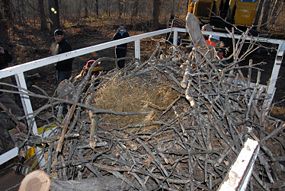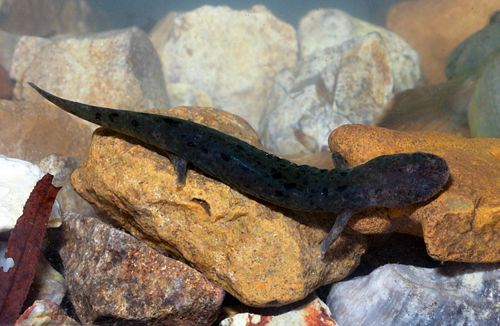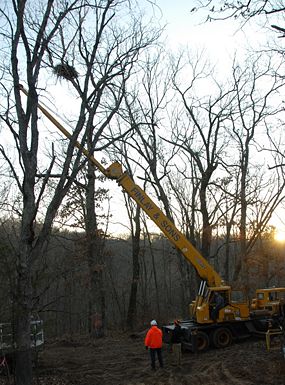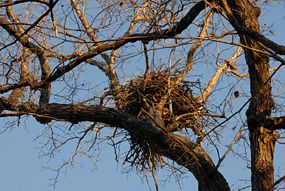Difference between revisions of "127.7 Threatened and Endangered Species"
m (→127.7.3.9 Post-Letting Activities: minor update) |
m (→127.7.3 Project Development Milestones: updated links) |
||
| Line 57: | Line 57: | ||
At the location/conceptual plan stage, the environmental specialist screens the project again but may also contact resource and regulatory agencies to determine whether they have any concerns with the project. | At the location/conceptual plan stage, the environmental specialist screens the project again but may also contact resource and regulatory agencies to determine whether they have any concerns with the project. | ||
| − | The district initiates this process by submitting an [[127.1 Request for Environmental Services|RES]] to the Design Division or for projects that require an Environmental Assessment ([[Environmental Classification| EA]]) or an Environmental Impact Statement ([[Environmental Classification| EIS]]), the design division and the district will determine when to begin this process. The district may be required to obtain and submit additional information about the project at this stage. Any findings pertinent to the project will be relayed to the district in the RES response and through core team participation. | + | The district initiates this process by submitting an [[127.1 Request for Environmental Services|RES]] to the Design Division or for projects that require an Environmental Assessment ([[127.26 Environmental Classification| EA]]) or an Environmental Impact Statement ([[127.26 Environmental Classification| EIS]]), the design division and the district will determine when to begin this process. The district may be required to obtain and submit additional information about the project at this stage. Any findings pertinent to the project will be relayed to the district in the RES response and through core team participation. |
===127.7.3.3 Interagency Coordination (Scoping)=== | ===127.7.3.3 Interagency Coordination (Scoping)=== | ||
| − | If the project requires an Environmental Assessment [[Environmental Classification|(EA)]] or an Environmental Impact Statement [[Environmental Classification|(EIS)]], environmental staff will contact the resource and regulatory agencies via written requests to solicit their comments concerning potential impacts to T&E species or other sensitive biological resources. | + | If the project requires an Environmental Assessment [[127.26 Environmental Classification|(EA)]] or an Environmental Impact Statement [[127.26 Environmental Classification|(EIS)]], environmental staff will contact the resource and regulatory agencies via written requests to solicit their comments concerning potential impacts to T&E species or other sensitive biological resources. |
===127.7.3.4 Development of Alternatives=== | ===127.7.3.4 Development of Alternatives=== | ||
Revision as of 11:00, 25 August 2010
Contents
- 1 127.7.1 Introduction
- 2 127.7.2 Process
- 3 127.7.3 Project Development Milestones
- 3.1 127.7.3.1 Initial Screening Stage
- 3.2 127.7.3.2 Location/Conceptual Plan Stage
- 3.3 127.7.3.3 Interagency Coordination (Scoping)
- 3.4 127.7.3.4 Development of Alternatives
- 3.5 127.7.3.5 Preliminary Plans Stage
- 3.6 127.7.3.6 Right of Way Plan Stage
- 3.7 127.7.3.7 Final Design Stage
- 3.8 127.7.3.8 Letting
- 3.9 127.7.3.9 Post-Letting Activities
- 4 127.7.4 Maintenance Activities
- 5 127.7.5 Bridge Demolition
127.7.1 Introduction
127.7.1.1 Overview
Threatened and endangered species considerations for MoDOT projects include potential impacts to rare plants, animals, critical habitat, and natural communities (e.g., caves). Approximately 745 plant species and 515 animal species in the United States are federally listed as threatened or endangered (T&E). However, only 10 federally listed plants and 25 federally listed animals are known to occur in Missouri.
Federal laws require FHWA and MoDOT to thoroughly address any potential impacts their projects might have on federally listed T&E species and eliminate or minimize those impacts. The Endangered Species Act of 1973 (ESA) additionally requires FHWA and MoDOT to consult with the U.S. Fish and Wildlife Service (FWS) regarding their projects and measures that can be implemented to minimize or eliminate project impacts to these species. The state of Missouri also tracks the status of approximately 1,047 plant and animal species that are considered rare in the state. Of these, 68 are listed as state endangered. The state Endangered Species Act and the Missouri Wildlife Code protect state listed species. MoDOT projects must also address potential impacts to state listed species.
127.7.1.2 Laws and Regulations
- Section 7 of the Endangered Species Act (ESA) of 1973 requires all federal agencies (MoDOT represents FHWA for this) to carry out programs for the conservation of threatened and endangered species. It also requires agencies to do consultation with the FWS for any project that might impact a federally listed species or its designated critical habitat. Click for more information on the Endangered Species Act.
- Section 2 of the Fish and Wildlife Coordination Act (FWCA) of 1958 (as amended) requires consultation with the FWS and the state fish and wildlife agency if a project is going to control or modify a stream or any other body of water. This consultation is to prevent loss of and damage to wildlife resources.
- The National Environmental Policy Act (NEPA) of 1969 (as amended) requires consideration of the physical environment for any project that uses federal funding or requires federal permits.
- The Missouri Cave Resources Act, Chapter 578, RSMo, protects caves from trespass, vandalism, contamination, and destruction.
- The Missouri Endangered Species Law, Chapter 252, RSMo, and 3 CSR 10 extends special protection to species that are listed as endangered in the state.
127.7.2 Process
The ESA requires FHWA and MoDOT to evaluate every project and determine whether the project could have a negative impact on any federally listed T&E species or their critical habitat. FHWA and MoDOT must use the best available scientific information to evaluate their projects and they must provide data to support their determination of impact. Under the ESA, no action can be taken that will jeopardize the continued existence of any federally listed threatened or endangered species or result in the destruction or adverse modification of critical habitat for such species. If an action is likely to have an impact on a T&E species or critical habitat, FHWA and MoDOT must consult with the FWS to determine how to eliminate or minimize those impacts. The assessment of potential impacts to T&E species should occur frequently throughout the development of each project because information regarding T&E species is constantly changing and being updated.

The district must complete and submit a Request for Environmental Services ( RES) to make the design division’s environmental section aware of a proposed project. Upon receiving an RES from the district, environmental staff will use publications, reports, and databases to screen the project and determine whether there are any known locations of federally or state listed species, critical habitat, or rare natural communities within the project limits or whether the project has the potential to impact a species that occurs nearby. The environmental specialist may also coordinate with FWS and the Missouri Department of Conservation (MDC) to determine whether the project is likely to impact any sensitive biological resources.
If the project screening and coordination with the resource agencies do not document the presence of any federally listed species or critical habitat, then the ESA requires no further coordination at that time. In a response to the RES, the environmental specialist will indicate that the project is clear of any T&E species constraints for that phase of the project’s development. However, the project will need to be reevaluated at each stage of development.
If it is determined that a federally listed T&E species, critical habitat, or other sensitive biological resource is present or is likely to occur within the project limits, FHWA and MoDOT are required to do ESA consultation with the FWS. The ESA describes two types of consultation, formal and informal.
| Informal Consultation |
| Informal consultation is done when a T&E species or critical habitat is known, or likely to occur, in the area of a proposed project but MoDOT (acting for FHWA) has determined that the project is “not likely to adversely affect” the species. Informal consultation can only be done if FHWA and MoDOT can provide data to show that they have removed all potential for their project to have an adverse affect on the species or its critical habitat. Informal consultation usually involves MoDOT environmental staff submitting a letter to FWS describing the project and providing information to show that the project is not likely to adversely affect the species. However, before the letter can be written, the environmental specialist may need to conduct site visits, coordinate with personnel from FWS and MDC, or hire consultants to conduct research to obtain additional information about the species or the habitat. The environmental specialist will also coordinate with the district to obtain specific details about the project and to determine what project modifications would be feasible (e.g., no tree cutting during bat breeding season). Once the letter is submitted to the FWS, they usually respond within 30 days. If they concur with the “not likely to adversely affect” determination, then Section 7 ESA consultation is complete and the project can proceed. If FWS does not concur with that determination, then formal consultation is necessary. Informal consultation with the FWS should begin at least one year prior to letting to allow time to complete the process and avoid project delays. |
| Formal Consultation |
| Formal consultation is required when it is determined that a project is likely to impact a federally listed species or critical habitat. The purpose of formal consultation is to identify and resolve potential conflicts between a proposed project and a T&E species or critical habitat. The process is initiated when FHWA submits a letter to the FWS requesting formal consultation for a project; a biological assessment (BA) usually accompanies the letter. MoDOT environmental staff (acting for FHWA) prepare the BA, which contains specific, detailed information on a federally listed threatened or endangered species or designated critical habitat that may be present in or near the project area. The BA also includes an impact assessment and describes conservation measures that will be implemented to eliminate or minimize the project’s impacts on the species. As with informal consultation, research may be necessary to collect additional information on the species. Because of all the information that needs to go into a BA and the importance of having the most current information available, preparing a BA takes a considerable amount of time. BA preparation requires close coordination with the district to determine specific information about the project and what modifications might be feasible. The ESA gives the FWS 135 days to respond once FHWA initiates formal consultation and submits the information necessary for the FWS to evaluate the project and its potential impacts. The FWS response includes a Biological Opinion in which the FWS provides reasonable and prudent measures that need to be incorporated into the project. These reasonable and prudent measures are intended to eliminate or minimize any negative impacts to the species. The Biological Opinion may also include an incidental take exemption that allows the take of a specified number of individuals of that species. Formal consultation should begin at least one to two years prior to letting to allow time to complete the process. |
127.7.2.1 District Responsibilities
The district is responsible for submitting an RES at each project milestone or annually if it has been a year since the last RES was submitted. Timely submittal of an RES is particularly important for T&E species because information on this topic can change rapidly. The district may be asked to provide additional detailed information about the project if necessary. The district may need to work with environmental staff and the U.S. Fish and Wildlife Service to determine measures that could be implemented to minimize the project’s impacts on T&E species. It is important that the district be involved in this process to assure that any suggested changes to the project are feasible for MoDOT.
127.7.2.2 Environmental Section Responsibilities
Upon receiving a completed RES from the district, environmental staff will review the project and provide the district with information about any potential environmental issues. Environmental staff will also specify what actions need to occur next in order to resolve these environmental issues and who needs to perform those actions (the district or the environmental section). Environmental staff, with help from district staff on technical information related to transportation project techniques, will handle all coordination with the resource agencies (i.e., U.S. Fish and Wildlife Service, Missouri Department of Conservation, etc.) and obtain any necessary clearances from these agencies. Environmental staff will also conduct any necessary surveys for T&E species that can be handled with MoDOT resources or they will coordinate any surveys that cannot be handled with MoDOT resources.
127.7.3 Project Development Milestones
127.7.3.1 Initial Screening Stage
At the initial project screening stage, the environmental specialist performs a cursory identification of potential issues related to T&E species or other sensitive biological resources. The environmental specialist reviews recent publications, reports, and databases related to these resources to determine whether any T&E species are known to occur in the area and the likelihood that the project will have a negative impact on such species or other biological resources.
The district initiates this process by submitting an RES to the design division. If the RES is completed in its entirety and includes a map of the project location, usually no additional information will be required from the district. Any findings pertinent to the project will be relayed to the district in the RES response, which will also indicate what type of coordination with FWS is believed necessary, if any.
127.7.3.2 Location/Conceptual Plan Stage
At the location/conceptual plan stage, the environmental specialist screens the project again but may also contact resource and regulatory agencies to determine whether they have any concerns with the project.
The district initiates this process by submitting an RES to the Design Division or for projects that require an Environmental Assessment ( EA) or an Environmental Impact Statement ( EIS), the design division and the district will determine when to begin this process. The district may be required to obtain and submit additional information about the project at this stage. Any findings pertinent to the project will be relayed to the district in the RES response and through core team participation.
127.7.3.3 Interagency Coordination (Scoping)
If the project requires an Environmental Assessment (EA) or an Environmental Impact Statement (EIS), environmental staff will contact the resource and regulatory agencies via written requests to solicit their comments concerning potential impacts to T&E species or other sensitive biological resources.
127.7.3.4 Development of Alternatives
Interagency coordination must be initiated prior to the development of alternatives and is to be used to guide alternatives development. This activity fulfills the requirements of NEPA and FWCA as they relate to the selection of alternatives and the information obtained is used in the EA or EIS documentation.
127.7.3.5 Preliminary Plans Stage
At the preliminary plans stage, if no T&E issues have been identified to date, a process similar to that described for the initial project screening is repeated. The district initiates this process by submitting an RES to the design division. The environmental specialist screens the project and verifies that no new information has become available since the last screening. Any new findings pertinent to the project will be relayed to the district in the RES response and the environmental specialist will discuss appropriate actions with the project manager.
At this stage if it has been determined that the project could have an impact on a T&E species or critical habitat, the environmental specialist will begin coordinating with FWS to determine the type of consultation (formal or informal, as discussed in EPG 127.7.2 Process) that will be necessary. Depending on the project’s schedule, the extent of the potential impact, the type of consultation necessary, the species impacted, etc., the environmental specialist may begin consultation with FWS at this stage. Many MoDOT projects require U.S. Army Corps of Engineers Section 404 permits and some require U.S. Coast Guard permits. These agencies will not issue permits until all ESA requirements have been completed with the FWS so it is important that coordination with the FWS begin early in the project development process. The district will need to provide additional information during consultation with FWS.
127.7.3.6 Right of Way Plan Stage
At the right-of-way plan stage, if no T&E issues have been identified to date, the process described for earlier stages is repeated. The district initiates this process by submitting an RES to the design division, whereupon the environmental specialist will screen the project and make sure no new information has become available since the last screening. Any new findings pertinent to the project will be relayed to the district in the RES response and the environmental specialist will discuss appropriate actions with the project manager.
At this stage, if it has been determined that the project could have an impact on a T&E species or critical habitat, consultation with FWS should be underway or should begin (refer to previous discussion in EPG 127.7.2 Process for details on consultation). The district will be asked to provide additional information about the project during consultation. District staff may also be asked to attend meetings/site visits and to help develop or comment on suggested conservation measures. The environmental specialist will keep the district involved throughout the consultation process to assure that no commitments are made that cannot be met.
127.7.3.7 Final Design Stage
At final design stage, if no T&E issues have been identified to date, the process described for earlier stages is repeated. The district submits an RES to the design division and the environmental specialist screens the project to verify that no new information has become available. Any new findings pertinent to the project are relayed to the district in the RES response and the environmental specialist will discuss appropriate actions with the project manager. If no threatened or endangered species issues are identified, the district will be notified that T&E issues are clear for this project.
At this stage, if it has been determined that the project could impact a T&E species or critical habitat, consultation with the FWS should be underway or already completed. The environmental specialist will keep the district informed of the status of this consultation and the projected completion date.
Job special provisions (JSPs) may be required to assure that the project avoids or minimizes impacts to known populations of T&E species, their habitats, or other sensitive biological resources. These JSPs are developed through coordination with the district, the environmental section, and the resource agencies, but the district usually writes the JSPs.
When special conservation measures are necessary to minimize or offset a project’s impacts, the district works with the environmental section to complete a plan that specifies how such measures will be accomplished and implemented. This plan must be approved by the appropriate regulatory agencies prior to letting. MoDOT should complete ESA consultation before the plans, specifications, and estimates (PS&E) submission date.
127.7.3.8 Letting
If any threatened or endangered species issues were identified during any of the previous phases of project development, MoDOT must obtain a letter from the FWS confirming that Section 7 ESA consultation requirements have been completed. This letter must be obtained prior to letting the project; it is a violation of the ESA to commit resources that cannot be reversed to a project prior to completing the Section 7 consultation requirements. If no threatened or endangered species issues have been identified, the district will be notified that T&E issues are clear for this project.
127.7.3.9 Post-Letting Activities

| Ever heard of a hellbender? No, it's not your average teen-ager or the co-worker who drives you crazy. It's an endangered salamander that the Missouri departments of Transportation and Conservation are working to protect. MoDOT learned of a large population of this funny-looking creature during the recent design phase of a bridge replacement project. The project site is one of the few places in the state where the hellbender is found. |
| The hellbender is a large salamander that needs fresh flowing uncontaminated water, a clean environment and a little bit of understanding. One of the largest salamanders in the world, it is peaceful, non-venomous and eats crayfish and the occasional minnow. Their population is declining because of habitat loss from silt caused by poorly managed land use and development. Because the salamanders are endangered in Missouri, MoDOT's project leaders had a difficult decision ahead of them. |
| "With some animals and plants, the task of relocating them before starting a project is easy," said Senior Environmental Specialist Alan Leary. "Since this animal is so specific to the habitat it must live in, we couldn't just pick it up and move it somewhere else. We had to carefully plan how it was going to be done." |
| Working together, MoDOT and MDC put together a team of divers and biologists to safely move and house the hellbender salamanders in a fish hatchery until the bridge project is complete. |
| MoDOT has a responsibility to protect endangered species and the environment while delivering transportation projects on time and within budget, although that balancing act can sometimes get tricky. |
| Great strides are being taken to keep this population healthy in Missouri. When the project is finished, large flat rocks will be placed in the river to recreate a suitable habitat and improve conditions for the returning hellbenders, as well as for other aquatic life. The animals will then be closely monitored to ensure these amphibians have a healthy chance of survival. Because no other organization has tried this before, the project can also be used as a national model. |
At this stage, the primary concern is assuring that all JSPs and special conservation measures are being implemented. Prior to construction, MoDOT resident engineers and inspectors should be informed of all issues and any special requirements or JSPs. Contractors should also be informed of these issues prior to construction. If MoDOT fails to implement the measures agreed upon during consultation with the FWS, the project can be shut down immediately and FHWA and MoDOT will have to start the consultation process over again. This can create lengthy project delays and result in significant fines.
127.7.4 Maintenance Activities
In certain areas, maintenance activities such as spraying, mowing, tree cutting, chip seals, etc. could impact a threatened or endangered species. These issues will be in specific areas and will be handled on a case-by-case situation. Roadside maintenance personnel have information regarding sensitive areas and they will assist the district in dealing with these issues. In other cases, the Design Division environmental specialist will notify the district of the issue and will coordinate with maintenance personnel and others in the district to determine the appropriate course of action (e.g., signing area restricting activities such as mowing, spraying, or excavating).
127.7.5 Bridge Demolition
Bridge demolition projects such as bridge blasting or the possibility of bridge material being knocked into the stream can have serious impacts to rare aquatic species. Demolition activities are to be described in each RES that is submitted for the construction of the new bridge, or a separate RES should be submitted well in advance of the letting date for the project. Either way, the process is the same as described previously for any other project. It is critical that the district make it clear that a bridge demolition will be part of the project or submit a separate RES for the demolition because there could be numerous T&E issues with a demolition that may not exist if the project simply involved construction of a new bridge.

